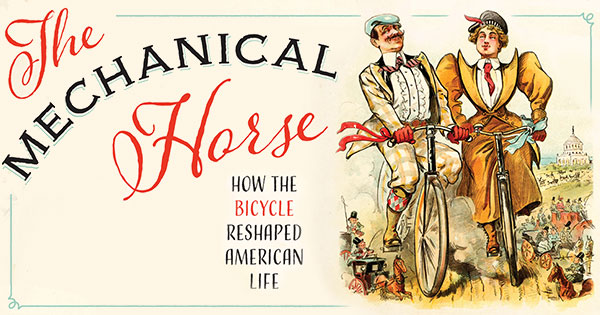The Mechanical Horse
Read an excerpt from Margaret Guroff’s new history of the bicycle in America

Go to just about any city in America, and it’s hard not to notice all the bike lanes, bike-sharing stations, and bike shops. Everywhere you look, a two-wheeler is pedaling through city gridlock.
But this isn’t the first time that bicycles were all the rage—it’s a machine that’s “gone from trendy to dorky and back again,” as Margaret Guroff points out in The Mechanical Horse. From the first bicycle frenzy of the 1890s to the 1950s—when “no self-respecting adult would ride one”—to the mania of the early ’70s, the velocipede has been the subject of scorn and worship in equal measure.
Read an excerpt from Guroff’s account of the last time bicycles were the coolest thing in town: 1981, when bike messengers ruled the streets of New York City.
By 1981 there were six hundred bicycle messengers in Manhattan, including at least one anthropologist doing field work: Jack M. Kugelmass, who sought to understand why riders wanted such a tough, risky job. Most couriers were desperate people who signed up as a last resort and quit as soon as they had another option, Kugelmass discovered. But the few who chose to stick with it long-term were a special breed, he believed: “Like heroes of the West, they are mavericks, resentful of conformity and rebelling against it. They are romantic adventurers who prefer the exhilaration of danger to civilization’s deadening routine.”
While most messengers rode ten-speeds, the scholar counted dozens who rode what he called “track bikes” and what we would now call “fixies”: single-speed, fixed-gear cycles designed for indoor racing. Like boneshakers and Ordinaries, fixies can’t coast: the pedals turn along with the chain that turns the rear wheel. Since the most hard-core fixie riders don’t use brakes, stopping such a bike can be tricky—the rider has to lock his or her legs to arrest the spinning pedals, without any assistance from a coaster brake that would use friction to stop the hub from spinning. Choosing to ride a fixed-gear bike in stop-and-go traffic might seem an odd choice, but couriers told Kugelmass they preferred the challenge. “It’s hard. It makes your life harrowing every day. It’s part of Zen,” a messenger named Ahdullah said. After weaving through traffic on a fixie, “you’re a bit keener and a bit swifter and a bit more relaxed about what just might come at you in life.”
The unusual bike choice was just part of a developing subculture with its own distinct style. Unfettered by the expectations of a nine-to-five office job, messengers dressed for both function and effect. Practical measures such as rolling up one pant leg—to keep the fabric from getting caught in the bicycle chain—became flourishes worn socially and copied by nonmessengers. As punk rock emerged in the mid-1970s, rockers with piercings, purple hair, and other body modifications gravitated to courier work, which “allowed people with mohawks to earn a living,” as a San Francisco messengers’ association brochure later stated. Messengers developed what the anthropologist Jeffrey L. Kidder called a “bricolage” of attire that both reflected and influenced punk, skateboard rat, and hip-hop style.
Some office workers envied the messengers’ freedom. In 1982, the Washington Post’s Henry Allen called them “phantoms who materialize smug and dripping to remind us that it is sleeting outside our offices—offices that make cowards of us all.”
From The Mechanical Horse by Margaret Guroff. Courtesy of University of Texas Press. Reprinted with permission.

